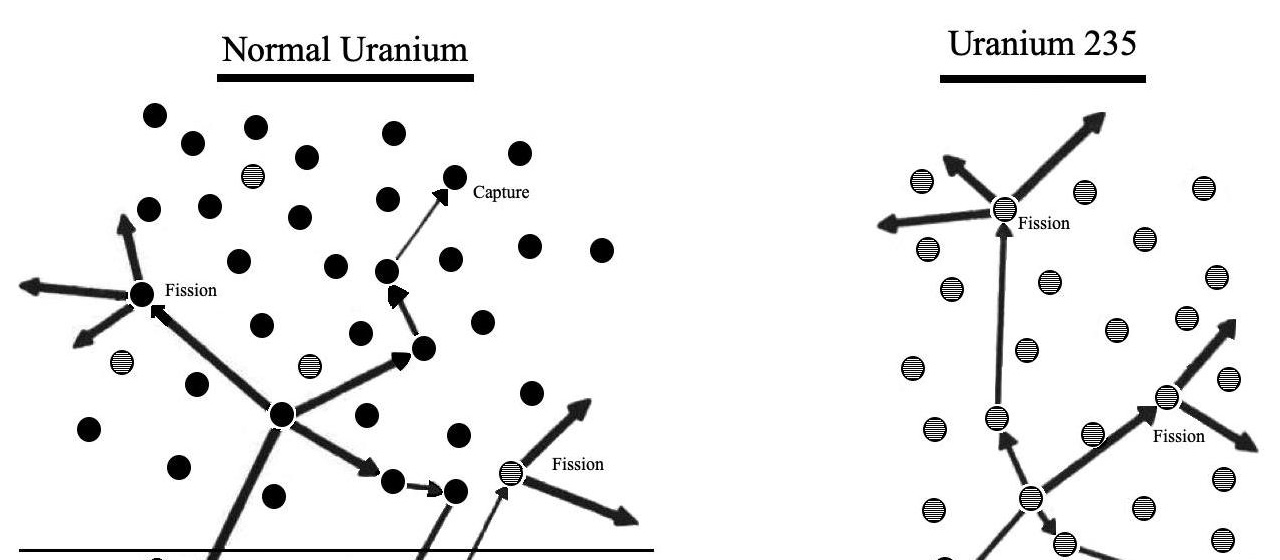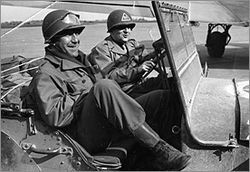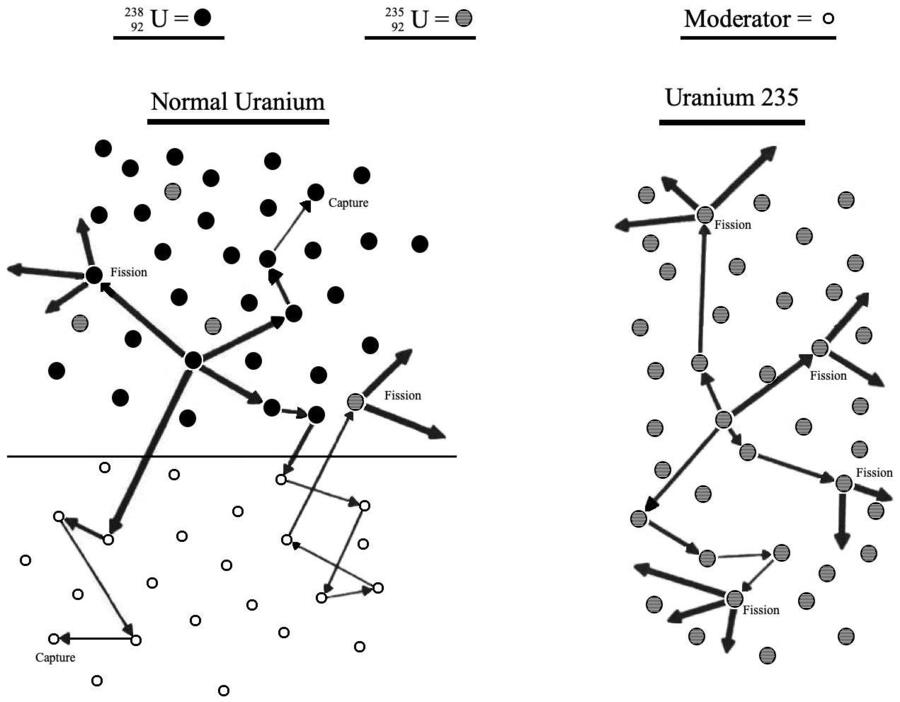Werner Heisenberg, Nuclear Weapons, and Farm Hall
Subject
After the end of the Second World War, a debate arose over Werner Heisenberg's understanding of how an atomic bomb would work. This controversy was fueled by conversations Heisenberg had with German colleagues while they were interned in England immediately after the war. How well did Heisenberg understand nuclear weapons?
Background/Context
As the Second World War was coming to an end, an Allied scientific intelligence gathering unit named the “Alsos Mission” followed behind the advancing Allied armies in search of a possible Nazi nuclear weapon. When the Alsos Mission entered Strasbourg late in 1944, it became clear to Samuel Goudsmit, the leading scientist in the mission, that there was no danger of a German atomic bomb. Alsos continued, however, gathering reports and materials, and arresting and interrogating scientists. The physicist Max von Laue and nine of the scientists who had worked on nuclear fission, uranium isotope separation, and nuclear reactors were interned by the Allies at several different sites in France and Belgium, finally being moved to an English country house in Godmanchester near Cambridge named Farm Hall, where their conversations were secretly recorded, translated, and summarized into reports.
In his 1947 book Alsos, Goudsmit claimed that Werner Heisenberg, Nobel laureate, one of the founders of quantum mechanics, and a leading scientist in the Geman "uranium project," had not understood that an atomic bomb would use fast neutrons, did not know that plutonium could be used in an atomic bomb, and thought that an atomic bomb would be a nuclear reactor gone out of control, something that would fizz, not explode. In other words, especially in the light of Hiroshima, the great Heisenberg appeared to have been in error. Although Goudsmit did not explictly refer to Farm Hall, his account suggested that he knew what had been said there.
The Farm Hall transcripts were published in 1996 and show that, when Heisenberg first heard the news of Hiroshima from radio broadcasts that provided very little technical detail, he was very skeptical and appeared uncertain about the size of the critical mass of an atomic bomb. Here the chemist Otto Hahn, one of the discoverers of nuclear fission, and Heisenberg are discussing how much fissionable material would be needed. [Bernstein 1996, 138-139]
Heisenberg: That would give them 30 kilograms a year.
Hahn: Do you think they would need as much as that?
Heisenberg: I think so certainly, but quite honestly I have never worked it out as I never believed one could get pure '[uranium] 235.' I always knew it could be done with '235' with fast neutrons. That’s why '235' only can be used as an explosive. One can never make an explosive with slow neutrons...
Heisenberg: ... If I have pure '235' each neutron will immediately beget two children and then there must be a chain reaction which goes very quickly. Then you can reckon as follows. One neutron always makes two others in pure '235.' That is to say, in order to make 1024 neutrons I need 80 reactions, one after the other. Therefore I need 80 collisions and the mean free path is about 6 centimeters. In order to make 80 collisions. I must have a lump of a radius of about 54 centimeters and that would be about a ton...
In fact the atomic bomb dropped on Hiroshima had only kilograms of uranium 235. However, there is no necessary connection between Heisenberg’s confusion about the critical mass of an atomic bomb and Goudsmit’s claim that Heisenberg conceived of an atomic bomb as a nuclear reactor gone out of control. Heisenberg’s initial calculations at Farm Hall, as inaccurate as they might be, are calculations of the critical mass of an atomic bomb, not of the minimum size of an operating nuclear reactor. Although Heisenberg subsequently derived a much more accurate estimate of critical mass while still in Farm Hall, in the judgment of the physicist and historian Jeremy Bernstein, who edited the Farm Hall transcripts, “in the end they understood very little” about nuclear weapons.
Source-Based Argument
As intriguing as postwar sources might be, what is most important is what primary sources from during the war tell us, when the Germans were actuallty working on uranium. One important such document is a talk Heisenberg gave in February 1942 to the Reich Research Council, the institution that was responsible for mobilizing academic research for the war effort. The audience included influential members of the German military and National Socialist political elite. Heisenberg employed the a diagram that, after the war, he described as:
showing, tailored for the level of understanding of a Reich minister of the time, the neutron increase in pure uranium 235, compared with that in a nuclear reactor composed of ordinary uranium and heavy water.
From Werner Heisenberg, "The Theoretical Basis for the Production of Energy from Uranium Fission” (26 February 1942).
In normal uranium, after a short distance a neutron released by fission could either collide with a uranium 238 nucleus and, if it possessed enough energy, fission it and thereby release new neutrons, or what unfortunately was much more probable, only transfer energy to the atomic nucleus without splitting it, whereby the neutron travels further with less energy. After a few such collisions the energy of the neutron would become so low, that there were only two possibilities for its subsequent fate: it could collide with a uranium 238 nucleus and be absorbed by it, or with one of the rare uranium 235 nuclei and fission it. In this case new neutrons would be produced and the processes described above could begin again. Some of the neutrons could escape through the outer surface of the uranium and thereby be lost for any further increase. In ordinary uranium the process of neutron absorption by uranium 238, which forms a new isotope uranium 239, occurred much more frequently than fission and neutron increase. Thus the desired chain reaction could not take place in ordinary uranium.
Heisenberg then made an analogy that fit well into the Nazi worldview. The behavior of neutrons in uranium could be compared to the behavior of a population, whereby the fission process is analogous to marriage with children and capture to death. In ordinary uranium the mortality rate far outweighed the number of births, so that an existing population would always die out after a short period of time. The only options for improving their prospects were: 1) increasing the number of births per marriage; 2) increasing the number of marriages; or 3) reducing the probability of death. Unfortunately, Heisenberg explained that the average number of neutrons released by fission was determined by natural laws and could not be changed.
An increase in the number of fissions could be achieved if the proportion of the rare isotope uranium 235, which could also be fissioned by low energy neutrons, was enriched. If it became possible to produce pure uranium 235, then the processes portrayed on the right side of the diagram were produced. After one or more collisions every neutron would cause a further fission, if it did not escape through the outer surface. Here the probability of death through capture was vanishingly small compared to the probability of neutron increase. Once the mass of uranium 235 was just large enough so that the neutron loss through the outer surface remained small compared to the increase inside, in other words, once it reached its critical mass, then the number of neutrons would increase tremendously, releasing the entire fission energy in a small fraction of a second.
The pure isotope uranium 235 therefore undoubtedly represents an explosive of utterly unimaginable effect. However, this explosive is very difficult to obtain. A large part of the Army Ordnance working group is devoted to the problem of enrichment or production of pure uranium 235. American research also appears to be placing special emphasis on this work.
Heisenberg noted that the uranium machines (nuclear reactors) they were developing could also manufacture nuclear explosives.
According to an idea from [Carl Friedrich von] Weizsäcker, as soon as such a machine was in operation, the question of explosives production takes a new turn. The transmutation of uranium in the reactor creates a new substance (element 94) [plutonium] that most probably just like pure uranium 235 is an explosive of the same unimaginable effect. However, this substance could be produced from ordinary uranium much easier than isotope 235 because it can be separated chemically. from uranium.
Heisenberg ended his talk by repeating the most striking potential applications of nuclear fission chain reactions.
… 1) it is undoubtedly possible to produce energy from uranium fission, if the enrichment of uranium 235 is successful. The production of pure uranium 235 would lead to an explosive of unimaginable effect; 2) ordinary uranium can also be exploited in a layer arrangement with heavy water. A layer arrangement of these materials can transfer its great energy potential over time to a thermal engine. It is thus a means to store great amounts of technically usable energy in relatively small amounts of material. Once the machine is in operation it can also lead to the production of a tremendously powerful explosive…
As the right-hand side of the diagram shows, Heisenberg understood that in a sufficiently large pure mass of fissionable material like uranium 235 or plutonium, nuclear fission and the resulting chain reaction would create an enormous explosion. This is what happens in the heart of an atomic bomb.
The February 1942 talk reveals that Heisenberg's basic understanding of how a nuclear weapon would work was sound. It also came at the time when Army Ordnance decided that nuclear weapons could not be built in time to be decisive for the war. All of the relevant authorities, Army Ordnance, the Reich Research Council, and the Minister of Armaments Albert Speer, agreed that the research was important enough to continue during wartime. Work continued on uranium isotope separation and uranium machines, but there is no evidence that Heisenberg or anyone else did further research on determining the critical mass of an atomic bomb. In fact the Americans, British, and émigrés only began working on the critical mass in earnest in 1943 after they had solved the problems of large-scale isotope separation and nuclear reactors, two milestones the Germans never achieved.
Conclusion
What does Heisenberg’s confusion at Farm Hall regarding the critical mass of an atomic bomb tell us, aside from the fact that, as the physicist himself said at Farm Hall, he had never made the calculation? The answer is: not very much.
One has to look elsewhere for an explanation of why there were no Nazi nuclear weapons.
Sources
Primary Sources
Werner Heisenberg, "Die theoretischen Grundlagen für die Energiegewinnung aus der Uranspaltung” (26 February 1942), Samuel Goudsmit Papers (SGP), American Institute of Physics, College Park, MD USA.
Werner Heisenberg to Samuel Goudsmit (5 January 1948) SGP.
Secondary Sources
Jeremy Bernstein (ed.), Hitler’s Uranium Club: The Secret Recordings at Farm Hall (Woodbury: AIP Press, 1996).
Samuel Goudsmit, Alsos (New York: Henry Schuman, 1947).
Mark Walker, German National Socialism and the Quest for Nuclear Power, 1939-1949 (Cambridge, Cambridge University Press, 1989); (German translation) Mark Walker, Die Uranmaschine. Mythos und Wirklichkeit der deutschen Atombombe (Berlin, Siedler Verlag, 1990)
Mark Walker, “Nuclear Weapons and Reactor Research at the Kaiser Wilhelm Institute for Physics,” in Susanne Heim, Carola Sachse, and Mark Walker (eds.), The Kaiser Wilhelm Society during National Socialism (Cambridge: Cambridge U. Press, 2009), 339-369; (German translation) Mark Walker, "Eine Waffenschmied? Kernwaffen- und Reaktorforschung am Kaiser-Wilhelm-Institut für Physik," in Helmut Maier (ed.), Gemeinschaftsforschung, Bevollmächtigte und der Wissentransfer. Die Rolle der Kaiser-Wilhelm-Gesellschaft im System kriegsrelevanter Forschung des Nationalsozialismus (Göttingen: Wallstein Verlag, 2007), 352-394.
Mark Walker, “A Biography of the German Atomic Bomb,” in Christian Forstner and Mark Walker (eds.), Biographies in the History of Physics: Actors, Objects, Institutions (Cham: Springer: 2020), 163-177.
Mark Walker, "Did Werner Heisenberg Understand How Atomic Bombs Worked?" Berichte zur Wissenschaftsgeschichte (forthcoming).




